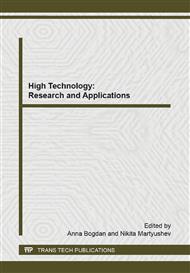[1]
O.A. Kaibushev, Plasticity and superplasticity of metals, Metallurgy, Moscow, (1975).
Google Scholar
[2]
F. Li, W.T. Roberts, P.S. Bate, Superplastisity and the development of dislocation structures in an Al-4. 5% Mg alloy, Acta mater 44 (1996) 217-233.
DOI: 10.1016/1359-6454(95)00141-8
Google Scholar
[3]
D. Li, D. Lin, Microstructure evolution and activation energy during superplastic deformation of FeAl based intermetallics, Scripta Materialia 36 (1997) 1289-1294.
DOI: 10.1016/s1359-6462(97)00021-3
Google Scholar
[4]
M.G. Zelin, On micro–superplasticity, Acta Materialia 45 (1997) 3533-3542.
DOI: 10.1016/s1359-6454(97)00065-7
Google Scholar
[5]
P. Van Houtte, S. Li, M. Seefeldt, L. Delannay, Deformation texture prediction: from the Taylor model to the advanced Lamel , Int. J. Plasticity 21 (2005) 589-624.
DOI: 10.1016/j.ijplas.2004.04.011
Google Scholar
[6]
A.M. Habraken, Modelling the plastic anisotropy of metals/Arch. Comput. Meth. Engng. 11 (2004) 3-96.
Google Scholar
[7]
P. Van Houtte, Crystal plasticity based modelling of deformation textures, Microstructure and texture in steels, Springer, 2009, 209-224.
DOI: 10.1007/978-1-84882-454-6_12
Google Scholar
[8]
P.V. Trusov, A.I. Shveykin, Multilevel crystal plasticity models of single- and polycrystals. Statistical models, Physical Mesomechanics 16 (2013) 23-33.
DOI: 10.1134/s1029959913010037
Google Scholar
[9]
P.V. Trusov, A.I. Shveykin, Multilevel crystal plasticity models of single- and polycrystals. Direct models, Physical Mesomechanics 16 (2013) 99-124.
DOI: 10.1134/s1029959913020021
Google Scholar
[10]
P.V. Trusov, A.I. Shveykin, E.S. Nechaeva, P.S. Volegov, Multilevel models of inelastic deformation of materials and their application for description of internal structure evolution, Physical Mesomechanics 15 (2012) 155-175.
DOI: 10.1134/s1029959912020038
Google Scholar
[11]
P.V. Trusov, P.S. Volegov, A.I. Shveykin, Multilevel model of inelastic deformation of FCC polycrystalline with description of structure evolution, Computational Materials Science 79 (2013) 429-441.
DOI: 10.1016/j.commatsci.2013.06.037
Google Scholar
[12]
V.E. Panin, V.E. Egorushkin, T.F. Elsukova. Physical mesomechanics of grain boundary sliding in a deformable polycrystal, Physical Mesomechanics, 14 (2011) 15-22.
DOI: 10.1134/s1029959913010013
Google Scholar


